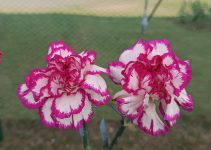Bayberry
Myrica pensylvanica
Bayberry forms a beautiful semi-evergreen shrub that tolerates either wet or dry soils. The shrub also withstands salt spray, making it a good choice for coastal landscapes. Plants gradually spread from underground suckers, eventually forming a thicket. Pruning is rarely necessary.
Bayberry has long been prized for its fragrant, waxy gray berries, which can be used to make candles. Plants are either male or female; to ensure berry production, plant several shrubs in the same landscape. The berries are also attractive to a wide range of songbirds.
Light: Part Sun, Sun
Type: Herb, Shrub
Height: 3 to 8 feet
Width: To 8 feet wide
Seasonal features: Spring bloom
Problem solvers: Drought tolerance, Slope/Erosion control
Special features: Attracts birds, Fragrance, Low maintenance
Zones: 3-7
Growing Bayberry Shrubs
Plant bayberry shrubs from nursery plants or cuttings in early spring. Amend the soil with compost, but don’t add fertilizer. Space bayberry shrubs at least 4 to 6 feet apart, depending on the species. Mulch the soil with 2 inches of wood chips or bark to keep weeds down and conserve moisture. Water at least weekly during the first year as the roots become established. Once the plants mature, they rarely need watering except during very dry conditions.
Prune bayberries in the spring to remove any dead or diseased branches, as well as to control growth. Cut branches back to a healthy lateral bud. In general, bayberry shrubs rarely need fertilizer unless growth is slow. Avoid giving them excessive nitrogen fertilizer, which can make them more prone to disease.
Problems
Bayberry shrubs are dioecious, meaning that only female plants produce berries. Make sure you plant at least one male plant among your plantings.
Bayberry shrubs are cold-loving plants that don’t fare well in heat and humidity. The leaves may become chlorotic in very alkaline soil. Add peat moss or sulfur to alkaline soil and use an acidic fertilizer annually. The plants are generally disease- and pest-free, but they can be affected by leaf spots, root rots and stem rots. Treat leaf spots by removing dead and diseased material. Space the plants so air circulates freely and use drip systems instead of overhead sprinklers. In some cases, you might want to apply a fungicide labeled for use on bayberry shrubs. Root and stem rots often occur in heavy, poorly-draining soil. Although the plants tolerate occasional flooding, especially in native settings, they’ll grow better if the soil drains adequately. Add compost or manure to improve drainage or consider using raised beds in very wet areas.


